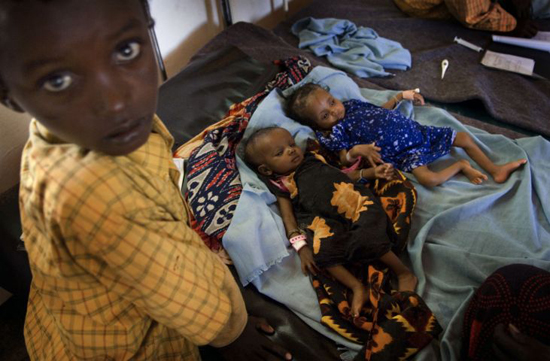"What is new is that people are now fleeing the rural areas simply because they have no more food to eat.”

Somalia 2011 © Magnus Hallgren
At MSF's hospital in Marere, children are treated for malnutrition.
While more than 2,000 Somalis cross borders into Kenya and Ethiopia every day in search of assistance, in Somalia itself the movement of people desperately seeking food and medical help is also taking on unseen proportions. MSF teams in Somalia are dealing with fast-rising numbers of displaced families that come over great distances to reach MSF’s hospitals and therapeutic feeding centers.
Luul Sankus walked with her husband and children for more than 160 kms (100 miles) to reach the village of Hurufle in the Juba Valley, located in southern Somalia.
“I haven’t seen our home region for over nine months now," she said. "We are farmers and when the rains failed nothing was left for us where we come from. My husband and two of our children walked all the way to Hurufle, where we now live as displaced people. When we came to Hurufle, our son fell ill; there was no treatment, no shelter, and no food. I was advised that I should take him to the MSF hospital in Marere. That’s why I am here.”
People are now leaving their villages, as well as rural areas, en masse because crops have failed and livestock are dying.
“Displacement is nothing new to Somalis,” said MSF Operations Manager Joe Belliveau. “For the past few years, hundreds of thousands of people have fled the violence in Mogadishu and elsewhere. What is new is that people are now fleeing the rural areas simply because they have no more food to eat.”
Camps for displaced people are popping up inside Somalia wherever people feel they have a better chance of getting help. For example, in the village of Jilib in Lower Juba Valley, around 5,000 people have spontaneously settled in a camp in the hope of receiving support from the community, the authorities, or MSF.
MSF is currently running nine medical-nutritional programs in south-central Somalia, most of them in territories controlled by al-Shabaab, one of the main armed factions in the country. These programs, together with MSF’s three large-scale projects in refugee camps in Kenya and Ethiopia, conduct thousands of medical consultations daily. Currently, teams are treating more than 10,000 severely malnourished children.
“In several parts of Somalia, this is the worst situation we’ve seen in the past decade,” Belliveau said. “Normal coping mechanisms are exhausted and many people have reached their limits. MSF is prepared to do more but to do so we need certain restrictions to be lifted. If MSF is allowed to send in international technical experts to work alongside our more than 1,000 Somali staff and we are permitted to send in supply flights with therapeutic feeding and other medicines, then we can scale up further.”
MSF has worked continuously in Somalia since 1991 and currently provides free medical care in eight regions of southern Somalia. More than 1,400 Somali staff, supported by approximately 100 staff in Nairobi, provide free primary healthcare, malnutrition treatment, healthcare and support to displaced people, surgery, water and relief supply distributions. MSF does not accept any government funding for its projects in Somalia; all its funding comes from private donors.




